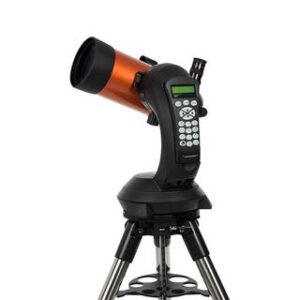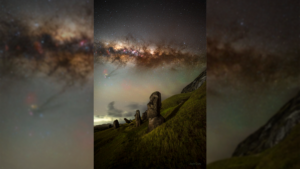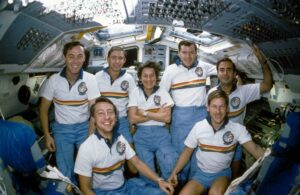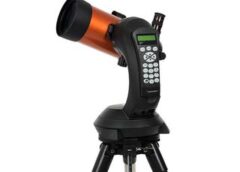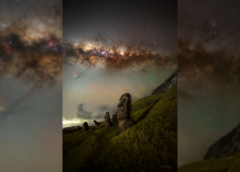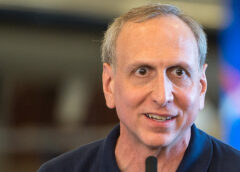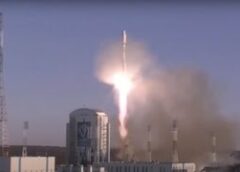23 Min Read The Marshall Star for December 6, 2023 Marshall Kicks Off Holiday Season with Tree-Lighting Ceremony NASA’s Marshall Space Flight Center celebrated its annual tree-lighting ceremony in the courtyard of Building 4221 on Nov 30. NASA Marshall Space Flight Center team members and family members form a circle as they bask in the light of the 32-foot artificial tree decorated with blue lights and a 10-pointed star representing each NASA center. NASA/Charles Beason Marshall team members and their children gathered for the lighting of the 32-foot artificial tree…
Read MoreNASA marks 25th anniversary of ISS with call to crew on space station
Twenty-five years ago, Bob Cabana was at the aft flight deck controls of the space shuttle Endeavour when he fired the orbiter’s thrusters to connect a U.S.-built node with a Russian module in Earth orbit. The burst closed the short distance between “Unity” and “Zarya,” giving birth to the International Space Station (ISS). “I cannot believe it was 25 years ago today that we grappled Zarya and joined it with the Unity node,” said Cabana, now NASA‘s outgoing associate administrator, in a call to the space station’s 70th expedition crew…
Read More25 Years Ago: NASA, Partners Begin Space Station Assembly
NASA is marking 25 years since the first two elements of the International Space Station were launched and joined in space. Today, the space station remains a global endeavor with 273 people from 21 countries now having visited the microgravity laboratory and has hosted more than 3,700 research and educational investigations from people in 108 countries and areas. Left: Launch of space shuttle Endeavour from NASA’s Kennedy Space Center in Florida on the STS-88 mission to deliver the Unity Node 1 module. Middle: The STS-88 crew. Right: The Unity Node…
Read MoreSatellites watch as Japan’s new volcanic island continues to grow (image)
A new image taken from space shows that an island forged in volcanic fire on the Pacific Seas off Japan at the end of Oct. 2023 is still rising from the sea. The new volcanic island, which has been named Niijima — meaning “new island” in Japanese — was imaged by the European Space Agency’s (ESA’s) Copernicus Sentinel-2 satellite on Nov. 27. The continued growth of the island shows that the underwater volcanic activity that birthed the island off the southern coast of Iwo Jima is continuing. The University of…
Read More25 Years Ago: The First Pieces of the International Space Station
NASA The mated Russian-built Zarya (left) and U.S.-built Unity modules are backdropped against the blackness of space and Earth’s horizon shortly after leaving Endeavour’s cargo bay on Dec. 13, 1998. A few days earlier, on Dec. 6, 1998, the space shuttle Endeavour, mission STS-88, launched from NASA’s Kennedy Space Center in Florida carrying the Unity connecting module and two pressurized mating adapters. The same day, the STS-88 crew captured the Russian Zarya module, launched Nov. 20, and mated it with the Unity node. Unity was the first piece of the International…
Read MoreNASA Invites Media to Northrop Grumman, SpaceX Space Station Launch
3 min read Preparations for Next Moonwalk Simulations Underway (and Underwater) The Northrop Grumman Cygnus spacecraft’s pressurized cargo module for the company’s 20th commercial resupply mission is lifted and moved by crane inside the high bay in the Space Station Processing Facility at NASA’s Kennedy Space Center in Florida. The Cygnus, aboard a SpaceX Falcon 9 rocket, will liftoff from Cape Canaveral Space Force Station’s Space Launch Complex 40. NASA/Ben Smegelsky Media accreditation is open for the next launch to deliver NASA science investigations, supplies, and equipment to the International…
Read MoreGravitational waves rippling from black hole merger could help test general relativity
Scientists have discovered gravitational waves stemming from a black hole merger event that suggest the resultant black hole settled into a stable, spherical shape. These waves also reveal the combo black hole may be much larger than previously thought. When initially detected on May 21, 2019, the gravitational wave event known as GW190521 was believed to have come from a merger between two black holes, one with a mass equivalent to just over 85 suns and the other with a mass equivalent to about 66 suns. Scientists believed the merger…
Read MoreWatch the explosive new trailer for astronaut action film ‘ISS’ (video)
The International Space Station has been a beacon of global cooperation and scientific research since it became operational in 2000. But what if this orbital base became a vantage point to witness the nuclear obliteration of our planet below? Thus begins the premise of a new sci-fi film from Bleecker Street titled, “I.S.S.,” where mutually assured destruction caused by an all-out atomic blitz on Earth transforms the International Space Station into a claustrophobic combat zone when American astronauts and Russian cosmonauts must each try to take control of the orbital…
Read MoreNASA’s Psyche spacecraft finds its ‘first light’ while zooming to a metal asteroid (image)
It was a big day for NASA’s Psyche spacecraft on Dec. 4, the day the probe finally opened its eyes to the universe. Since launching atop a SpaceX Falcon Heavy rocket on Oct. 13 — the first interplanetary mission for the Heavy, in fact — Psyche has been essentially traveling the cosmos in darkness, as scientists had yet to turn on the solar-winged craft’s cameras. It’s currently on its way to study the asteroid for which it’s named, 16 Psyche, that sits somewhere between our fellow solar system planets Mars…
Read MoreFaces of NASA features Ames…
Faces of NASA features Ames Research Center Pilot David Zahn In November 2023, “Faces of NASA” featured an aeronautics pilot from NASA Ames Research Center. Learn more about David Zahn and his story at https://www.nasa.gov/image-article/nasa-research-pilot-david-zahn/. David Zahn pilots the ownship aircraft in the VMS’s R-Cab during the AVA-1h simulation in the VMS at NASA Ames Research Center. NASA / Dominic Hart
Read More